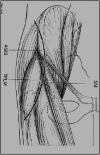Bernese Periacetabular Osteotomy: A Comparative Study of Four Types of Incisions
- PMID: 36732311
- PMCID: PMC9726307
- DOI: 10.5435/JAAOSGlobal-D-21-00090
Bernese Periacetabular Osteotomy: A Comparative Study of Four Types of Incisions
Abstract
Bernese periacetabular osteotomy has diverse complications associated with incisions, such as dehiscence, hypertrophy, depression, and hyperpigmentation on scars, which affect patient satisfaction. The objective was to evaluate aesthetics and satisfaction outcomes in four different incisions. We evaluated 176 incisions in 148 patients. The incisions performed were the original modified (16, group I), straight and shortened, (64, group II), "Z" shaped (16, group III), and oblique inguinal (48, group IV). The scars were evaluated for width and length, development of a hypertrophic scar, depression or hyperpigmentation, and dehiscence and resuture. A scale of satisfaction was applied (points ranging from 1 to 10). The Bartlett test and Kruskal-Wallis test were used. The mean width and length of the scars were 20.3 and 6.8 cm for group I, 6.5 and 8.1 for group II, 12.1 and 7.1 cm for group III, 13 and 1.4 cm for group IV, respectively. Hypertrophic scars were found in 18% in group I, 12.5% in group II, and 31.2% in group III. Depressed scars were found in 10.8% in group I and 7.1% in group II. Hyperpigmentation was found in 16% in groups I and II, 37% in group III, and 2% in group IV. Dehiscence was found in 8.1% in group I and 8.9% in group II. Satisfaction for group IV was nine points. The difference in length and width and satisfaction were statistically significant (P < 0.05). The oblique inguinal incision (group IV) showed a smaller percentage of complications, with an adequate aesthetic result, and a high grade of patient's satisfaction.
Copyright © 2022 The Authors. Published by Wolters Kluwer Health, Inc. on behalf of the American Academy of Orthopaedic Surgeons.
Figures









References
-
- Weber M, Ganz R: The anterior approach to hip and pelvis modified Smith-Petersen approach and its possibilities for extension. Orthop Traumatol 2002;10:245.
-
- Ganz R, Klaue K, Vinh TS, Mast JW: A new periacetabular osteotomy for the treatment of hip dysplasias. Technique and preliminary results. Clin Orthop 1988;232:26-36. - PubMed
-
- Hussell JG, Mast JW, Mayo KA, Howie DW, Ganz R: A comparison of different surgical approaches for the periacetabular osteotomy. Clin Orthop Relat Res 1999;363:64-72. - PubMed
-
- Pogliacomi F, Stark A, Vaienti E, Wallensten R: Periacetabular osteotomy of the hip: The ilioinguinal approach. Acta Biomed 2003;74:38-46. - PubMed
-
- Ko JY, Wang CJ, Lin CF, Shih CH: Periacetabular osteotomy through a modified Ollier transtrochanteric approach for treatment of painful dysplastic hips. J Bone Joint Surg Am 2002;84:1594-1604. - PubMed
MeSH terms
LinkOut - more resources
Full Text Sources

